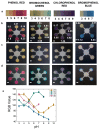Multiplexed Paper Microfluidics for Titration and Detection of Ingredients in Beverages
- PMID: 30875737
- PMCID: PMC6471555
- DOI: 10.3390/s19061286
Multiplexed Paper Microfluidics for Titration and Detection of Ingredients in Beverages
Abstract
Food safety and access to systematic approaches for ensuring detection of food hazards is an important issue in most developing countries. With the arrival of paper-based analytical devices (µPADs) as a promising, rapid, easy-to-use, and low-cost analytical tool, we demonstrated a simple microfluidic-based titration study for the analysis of packaged fruit juices. Similar, to the titration experiments using traditional glassware in chemistry laboratories, in this study the titration experiments were developed using paper microfluidics for the analysis of several analytes such as pH, vitamin C, sugars, and preservatives present in the packaged fruit juices. The allergen found commonly in dairy based mixtures and the non-pathogenic biochemical component responsible for food spoilage in cider based fruit juices were also determined. The results obtained using paper microfluidics were compared with those obtained using a conventional spectrophotometric technique. Finally, a paper microfluidics based multiplexed sensor was developed for the analysis of common nutritional ingredients, an allergen, and a non-pathogenic byproduct present in packaged fruit juices on a single platform. Overall, the results presented in this study reveal that the proposed paper microfluidic assisted colorimetric multiplexed sensor offers a quick and reliable tool for on-spot routine analysis for food safety applications.
Keywords: food safety and monitoring; microfluidic paper-based analytical device; multiplexed sensor; on-spot routine analysis; packaged fruit juice testing; ready-made test strips.
Conflict of interest statement
The authors declare no conflict of interest.
Figures







Similar articles
-
Challenges in assessing the quality of fruit juices: Intervening role of biosensors.Food Chem. 2022 Aug 30;386:132825. doi: 10.1016/j.foodchem.2022.132825. Epub 2022 Mar 26. Food Chem. 2022. PMID: 35367795 Review.
-
Recent Developments and Applications of Microfluidic Paper-Based Analytical Devices for the Detection of Biological and Chemical Hazards in Foods: A Critical Review.Crit Rev Anal Chem. 2023;53(2):233-252. doi: 10.1080/10408347.2021.1949695. Epub 2021 Jul 25. Crit Rev Anal Chem. 2023. PMID: 34304654 Review.
-
A quick and simple paper-based method for detection of furfural and 5-hydroxymethylfurfural in beverages and fruit juices.Food Chem. 2022 May 30;377:131532. doi: 10.1016/j.foodchem.2021.131532. Epub 2021 Nov 10. Food Chem. 2022. PMID: 35030337
-
Microfluidic paper-based aptasensor devices for multiplexed detection of pathogenic bacteria.Biosens Bioelectron. 2022 Jul 1;207:114214. doi: 10.1016/j.bios.2022.114214. Epub 2022 Mar 24. Biosens Bioelectron. 2022. PMID: 35349894
-
A Chemically Patterned Microfluidic Paper-based Analytical Device (C-µPAD) for Point-of-Care Diagnostics.Sci Rep. 2017 Apr 26;7(1):1188. doi: 10.1038/s41598-017-01343-w. Sci Rep. 2017. PMID: 28446756 Free PMC article.
Cited by
-
Parallel Monitoring of Glucose, Free Amino Acids, and Vitamin C in Fruits Using a High-Throughput Paper-Based Sensor Modified with Poly(carboxybetaine acrylamide).Biosensors (Basel). 2023 Nov 28;13(12):1001. doi: 10.3390/bios13121001. Biosensors (Basel). 2023. PMID: 38131761 Free PMC article.
-
Recent Advances in Microfluidic Paper-Based Analytical Devices toward High-Throughput Screening.Molecules. 2020 Jun 28;25(13):2970. doi: 10.3390/molecules25132970. Molecules. 2020. PMID: 32605281 Free PMC article. Review.
-
Progress and Challenge of Sensors for Dairy Food Safety Monitoring.Sensors (Basel). 2024 Feb 21;24(5):1383. doi: 10.3390/s24051383. Sensors (Basel). 2024. PMID: 38474919 Free PMC article. Review.
-
Increasing the packing density of assays in paper-based microfluidic devices.Biomicrofluidics. 2021 Feb 4;15(1):011502. doi: 10.1063/5.0042816. eCollection 2021 Jan. Biomicrofluidics. 2021. PMID: 33569089 Free PMC article. Review.
-
Accuracy improvement via novel ratiometry design in distance-based microfluidic paper based analytical device: instrument-free point of care testing.RSC Adv. 2023 May 23;13(23):15704-15713. doi: 10.1039/d3ra01601c. eCollection 2023 May 22. RSC Adv. 2023. PMID: 37228680 Free PMC article.
References
-
- Ismail B., Reuhs B.L., Nielsen S.S. Food Analysis. Springer; Berlin, Germany: 2010. Analysis of food contaminants, residues, and chemical constituents of concern; pp. 317–349.
MeSH terms
Grants and funding
LinkOut - more resources
Full Text Sources

